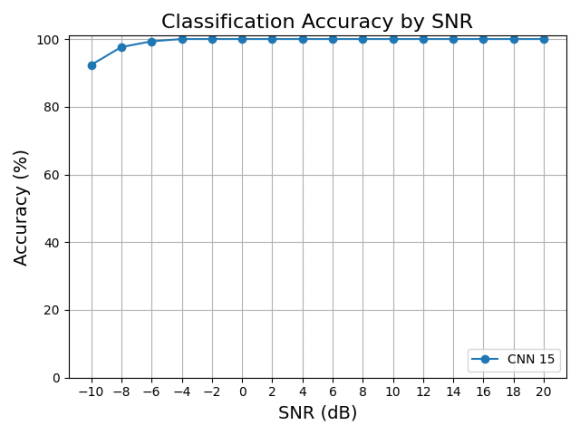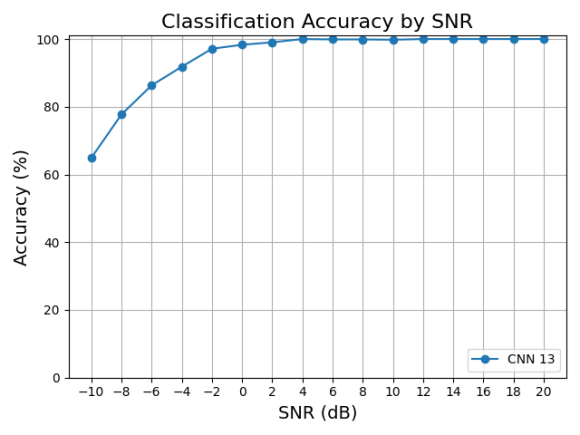Matlab waveform generation with added AWGN for Deep learning classification.
 Started by 2 weeks ago●2 replies●latest reply 2 weeks ago●106 views
Started by 2 weeks ago●2 replies●latest reply 2 weeks ago●106 viewsHello,
I am generating WLAN 802.11n/ac waveforms with 4 different modulation schemes (BPSK, QPSK, 16-QAM, 256-QAM) and feed the I/Q data into my Deep learning model to classify. I am also adding AWGN so I get SNR values from -10 dB to 20 dB with a step of 2 dB.
The results are very surprising, The model is performing very well at pretty low SNR.
I tried to add comm.RicianChannel() function and it got only a little bit worse:
Is this possible? I was expecting for the model to have difficulties classifying 802.11n/ac waveforms. This is how I add AWGN:
for j = -10:2:20;
...
noise_ = 10^(-j/10);
noise = randn(size(Data))*sqrt(noise_/2)+1i*randn(size(Data))*sqrt(noise_/2);
Data= Data+ noise;
...
% Also adding a little phase offset and Amplitude imbalance

You don't show how "Data" is calculated, so it's impossible to be certain, but I suspect your calculation is wrong (unless the signal power happens to be exactly 1).
SNR is defined as the ratio between the signal power and the noise power. In your code, it looks like you want "j" to mean SNR (in dB), because you wrote:
I am also adding AWGN so I get SNR values from -10 dB to 20 dB with a step of 2 dB.
In my opinion, it would be better to rename "j" to something more descriptive like "snr_db". Nonetheless, we're saying that j = 10log10(signal_power / noise_power).
It looks like you want "noise_" to mean noise power. Therefore, a much better variable name would be "noise_power". Nonetheless, we can rearrange j = 10log10(signal_power / noise_) to get:
noise_ = signal_power * 10^(-j/10)
Your calculation doesn't appear to account for the signal power.

Hello and thanks for the answer! I actually saw my awgn adding method in a different post on this forum, wanted to switch from the awgn() function because I got even more accurate results with it. Here is my original code on generating 802.11n/ac scheme with 16-QAM modulation scheme:
clear variables
close all
clc
%% Generating Ricean channel
fs = 3.84e6;% Sample rate in Hz
pathDelays = [0 200 800 1200 2300 3700]*1e-9; % in seconds
avgPathGains = [0 -0.9 -4.9 -8 -7.8 -23.9];% dB
kfact = 10;% Rician K-factor
fD = 50;% Max Doppler shift in Hz
ricianChan = comm.RicianChannel( ...
SampleRate=fs, ...
PathDelays=pathDelays, ...
AveragePathGains=avgPathGains, ...
KFactor=kfact, ...
MaximumDopplerShift=fD);
%% Generating 802.11n/ac (OFDM) waveform
% 802.11n/ac (OFDM) configuration
vhtCfg = wlanVHTConfig('ChannelBandwidth', 'CBW80', ... % CBW80
'NumUsers', 1, ...
'NumTransmitAntennas', 1, ...
'NumSpaceTimeStreams', 1, ...
'SpatialMapping', 'Direct', ...
'STBC', false, ...
'MCS', 4, ... % setting 16-QAM
'ChannelCoding', 'BCC', ...
'APEPLength', 1024, ...
'GuardInterval', 'Long', ...
'GroupID', 63, ...
'PartialAID', 275);
numPackets = 1500; % Intended number of packets
desired_Length = 256; % Desired length of each packet in samples
%% Impairments parameters
SNRs = -10:2:20; % AWGN values
phase_offsets = [-pi/18, -pi/36, 0, pi/36, pi/18];% Possible phase offsets that can occur
amplitude_imbalances = [-10, -5, 0, 5, 10];% In [%]
amplitude_imbalances = 20*log10(1+amplitude_imbalances*0.01); % Converting to dB
for j = SNRs
waveform = [];
for i = 1:numPackets
% input bit source:
in = randi([0, 1], 100, 1);
packet_Waveform = wlanWaveformGenerator(in, vhtCfg, ...
'NumPackets', 1, ...
'IdleTime', 0, ...
'OversamplingFactor', 1, ...
'ScramblerInitialization', 93, ...
'WindowTransitionTime', 1e-07);
% Apply the Rician channel model to the waveform
packet_Waveform = ricianChan(packet_Waveform);
%% Downsample the waveform
%Definition of downsampling factor
downsamplingFactor = max(1, floor(length(packet_Waveform) / desired_Length));
downsampled_Waveform = downsample(packet_Waveform, downsamplingFactor);
downsampled_Waveform = downsampled_Waveform(1:min(desired_Length, end));
%% Adding Impairments
% Adding awgn
noise_ = 10^(-j/10);
noise = randn(size(downsampled_Waveform))*sqrt(noise_/2)+1i*randn(size(downsampled_Waveform))*sqrt(noise_/2);
downsampled_Waveform = downsampled_Waveform + noise;
% Adding Phase offset
downsampled_Waveform = downsampled_Waveform * exp(1i*phase_offsets(randi(numel(phase_offsets))));
% Adding IQ imbalance - Amplitude imbalance
downsampled_Waveform = iqimbal(downsampled_Waveform, amplitude_imbalances(randi(numel(amplitude_imbalances))));
%% Adding packets to waveform
waveform = [waveform; downsampled_Waveform];% Append packet's waveform
end
%% Visualize
constel = comm.ConstellationDiagram('ColorFading', true, ...
'ShowTrajectory', 0, ...
'ShowReferenceConstellation', false);
segmentIndex = 1; % Change this to visualize different segments
constel(waveform((segmentIndex-1)*desired_Length+1:segmentIndex*desired_Length));
constel.Title = sprintf('Constellation diagram of 802.11n/ac (QAM16) %d dB',j);
%% Save Waveform Data
waveStruct.waveform = waveform
filename = sprintf('WLANnacQAM16/WLANnacQAM16_%ddB',j);
save(filename,'waveStruct')
end
I'm generating packets but then downsampling them in this case to 256. In total I generate 1500 packets for every SNR value + randomly inserting different phase offsets and amplitude imbalances and also adding rician before. Question: What is the way to generate signal_power?




















